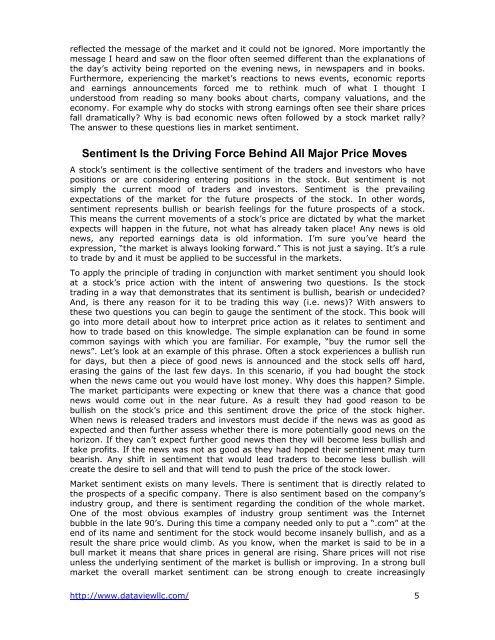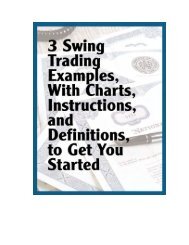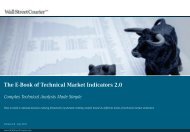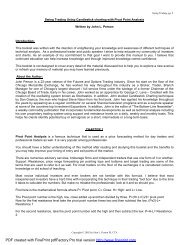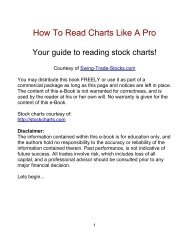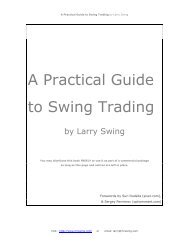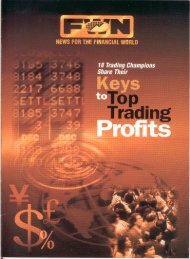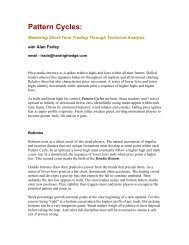Trading the Opening Range - The Swing Trading Guide
Trading the Opening Range - The Swing Trading Guide
Trading the Opening Range - The Swing Trading Guide
You also want an ePaper? Increase the reach of your titles
YUMPU automatically turns print PDFs into web optimized ePapers that Google loves.
eflected <strong>the</strong> message of <strong>the</strong> market and it could not be ignored. More importantly <strong>the</strong><br />
message I heard and saw on <strong>the</strong> floor often seemed different than <strong>the</strong> explanations of<br />
<strong>the</strong> day’s activity being reported on <strong>the</strong> evening news, in newspapers and in books.<br />
Fur<strong>the</strong>rmore, experiencing <strong>the</strong> market’s reactions to news events, economic reports<br />
and earnings announcements forced me to rethink much of what I thought I<br />
understood from reading so many books about charts, company valuations, and <strong>the</strong><br />
economy. For example why do stocks with strong earnings often see <strong>the</strong>ir share prices<br />
fall dramatically Why is bad economic news often followed by a stock market rally<br />
<strong>The</strong> answer to <strong>the</strong>se questions lies in market sentiment.<br />
Sentiment Is <strong>the</strong> Driving Force Behind All Major Price Moves<br />
A stock’s sentiment is <strong>the</strong> collective sentiment of <strong>the</strong> traders and investors who have<br />
positions or are considering entering positions in <strong>the</strong> stock. But sentiment is not<br />
simply <strong>the</strong> current mood of traders and investors. Sentiment is <strong>the</strong> prevailing<br />
expectations of <strong>the</strong> market for <strong>the</strong> future prospects of <strong>the</strong> stock. In o<strong>the</strong>r words,<br />
sentiment represents bullish or bearish feelings for <strong>the</strong> future prospects of a stock.<br />
This means <strong>the</strong> current movements of a stock’s price are dictated by what <strong>the</strong> market<br />
expects will happen in <strong>the</strong> future, not what has already taken place! Any news is old<br />
news, any reported earnings data is old information. I’m sure you’ve heard <strong>the</strong><br />
expression, “<strong>the</strong> market is always looking forward.” This is not just a saying. It’s a rule<br />
to trade by and it must be applied to be successful in <strong>the</strong> markets.<br />
To apply <strong>the</strong> principle of trading in conjunction with market sentiment you should look<br />
at a stock’s price action with <strong>the</strong> intent of answering two questions. Is <strong>the</strong> stock<br />
trading in a way that demonstrates that its sentiment is bullish, bearish or undecided<br />
And, is <strong>the</strong>re any reason for it to be trading this way (i.e. news) With answers to<br />
<strong>the</strong>se two questions you can begin to gauge <strong>the</strong> sentiment of <strong>the</strong> stock. This book will<br />
go into more detail about how to interpret price action as it relates to sentiment and<br />
how to trade based on this knowledge. <strong>The</strong> simple explanation can be found in some<br />
common sayings with which you are familiar. For example, “buy <strong>the</strong> rumor sell <strong>the</strong><br />
news”. Let’s look at an example of this phrase. Often a stock experiences a bullish run<br />
for days, but <strong>the</strong>n a piece of good news is announced and <strong>the</strong> stock sells off hard,<br />
erasing <strong>the</strong> gains of <strong>the</strong> last few days. In this scenario, if you had bought <strong>the</strong> stock<br />
when <strong>the</strong> news came out you would have lost money. Why does this happen Simple.<br />
<strong>The</strong> market participants were expecting or knew that <strong>the</strong>re was a chance that good<br />
news would come out in <strong>the</strong> near future. As a result <strong>the</strong>y had good reason to be<br />
bullish on <strong>the</strong> stock’s price and this sentiment drove <strong>the</strong> price of <strong>the</strong> stock higher.<br />
When news is released traders and investors must decide if <strong>the</strong> news was as good as<br />
expected and <strong>the</strong>n fur<strong>the</strong>r assess whe<strong>the</strong>r <strong>the</strong>re is more potentially good news on <strong>the</strong><br />
horizon. If <strong>the</strong>y can’t expect fur<strong>the</strong>r good news <strong>the</strong>n <strong>the</strong>y will become less bullish and<br />
take profits. If <strong>the</strong> news was not as good as <strong>the</strong>y had hoped <strong>the</strong>ir sentiment may turn<br />
bearish. Any shift in sentiment that would lead traders to become less bullish will<br />
create <strong>the</strong> desire to sell and that will tend to push <strong>the</strong> price of <strong>the</strong> stock lower.<br />
Market sentiment exists on many levels. <strong>The</strong>re is sentiment that is directly related to<br />
<strong>the</strong> prospects of a specific company. <strong>The</strong>re is also sentiment based on <strong>the</strong> company’s<br />
industry group, and <strong>the</strong>re is sentiment regarding <strong>the</strong> condition of <strong>the</strong> whole market.<br />
One of <strong>the</strong> most obvious examples of industry group sentiment was <strong>the</strong> Internet<br />
bubble in <strong>the</strong> late 90’s. During this time a company needed only to put a “.com” at <strong>the</strong><br />
end of its name and sentiment for <strong>the</strong> stock would become insanely bullish, and as a<br />
result <strong>the</strong> share price would climb. As you know, when <strong>the</strong> market is said to be in a<br />
bull market it means that share prices in general are rising. Share prices will not rise<br />
unless <strong>the</strong> underlying sentiment of <strong>the</strong> market is bullish or improving. In a strong bull<br />
market <strong>the</strong> overall market sentiment can be strong enough to create increasingly<br />
http://www.dataviewllc.com/ 5


